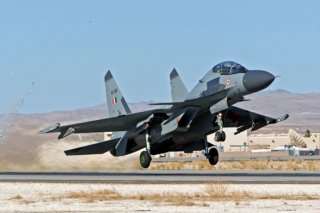A Sight to Behold: Watch This Russian Fighter Do A Terrifying Barrel Roll
Russia showed off the Su-30 to potential customers with a stunning combination of maneuvers.
Here's What You Need to Remember: The Knights’ performance illustrates the seriousness with which Russia has treated its LIMA showings.
The “Russian Knights” aerobatic team took to the Malaysian skies last year at the LIMA-2019 Aerospace and Maritime exhibition with one of their most technically demanding performances in years.
Flying in a tight formation of four Su-30SM fighters, the Knights performed a synchronized Nesterov loop filmed from an attached camera of the leftmost jet. Two of the fighters went on to perform a variant of the mirror maneuver, which involves one plane parallel flying on its back above another. One of the Su-30SM’s can be seen executing the falling leaf trick; that is, a stall that transitions into an induced horizontal spin. Finally, a Knights routine wouldn’t be complete without their close-distance crisscrossing barrel rolls. None of these maneuvers are new to the Russian Knights, but they are seldom performed as part of the same routine.
The Knights’ performance illustrates the seriousness with which Russia has treated its recent LIMA showings. This should hardly be surprising, given that the Asia-Pacific region accounts for 20% of Russian military hardware contracts.
Rostec official Viktor Kladov noted that virtually all of the performing aircraft at LIMA-2019 were Russian-made: "I have met with the [Malaysian] Defense Ministry's leadership, who were all saying that 'Russians stole the show at the expo,' because there was no one but Russians in the sky: first, there were the Russian Knights, then they made way for the Russian Su-30MKM [fighters] of the Malaysian Air Force, and then Russian Yak-130, at least operated by Malaysian pilots, were amazing the crowd."
In fact, one of the pillars of the Knights’ branding is that their Su-30SM’s are serially produced. The message to prospective importers is clear: what you see is exactly what you will get.
Formed in 1991, the Russian Knights have traversed a rocky, and in many ways tragic, road to become the popular face of Russian military aviation. In 1995, three Knights Su-27’s crashed into a Vietnamese mountain during a botched refuelling run, claiming four lives. The cause of the catastrophe remains contested, but likely stemmed from a deadly cocktail of adverse weather and severe miscommunication with the Il-76 pilot escorting them.
More recently in 2009, Knights team captain Igor Tkachenko was killed when two Su-27’s collided during a practice session. As can be seen from the prior clips, the Knights’ routine is heavily saturated with paired close-contact maneuvers. They are as visually impressive as they are dangerous to practice and perform, with a razor thin margin of error separating the operator from potential death.
The Russian Knights swapped out their Su-27’s for the Su-30SM in 2016.
In the run-up to LIMA-2019, Kladov described the decision in glowing terms: “After a two-year hiatus, the aerobatic team “Russian Knights” returns to Malaysian skies. Furthermore, they’ve been performing not on the Su-27, but on the Su-30SM. The renowned team has been rearmed. To offer an appropriate comparison, it is like upgrading from a Volkswagen to a Mercedes.”
The Su-30SM does, in fact, offer numerous internal improvements over its four-decade old predecessor, especially in modernized onboard electronics and a much-expanded armament suite. It is a deeply modernized variant of the Su-30, itself a heavy, thrust-vectoring, long-range, and multirole advanced variant of the Su-27.
And yet, Kladov’s analogy is apt in more ways than one: a Mercedes offers more features than a Volkswagen, but doesn’t handle visibly better in most circumstances. As aircraft development pivots away from raw physical performance in favor of increasingly sophisticated avionics packages, it becomes increasingly difficult to distinguish newer aircraft within the narrow airshow format. As previously discussed, the F-35 is experiencing a similar problem vis-à-vis its F-22 counterpart.
Mark Episkopos is a frequent contributor to The National Interest and serves as research assistant at the Center for the National Interest. Mark is also a PhD student in History at American University. This article first appeared last year. Image: Flickr

